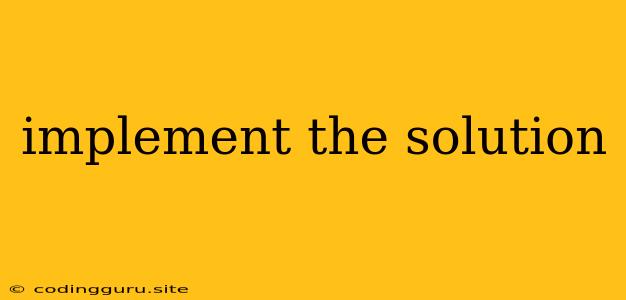Implementing the Solution: A Guide to Turning Ideas into Reality
In the realm of technology, innovation thrives on the ability to implement the solution. A brilliant idea, without a concrete plan for execution, is just a fleeting thought. This article will explore the essential steps involved in implementing the solution and transforming your concepts into tangible outcomes.
1. Define the Problem:
Before diving into implementation, it's crucial to have a clear understanding of the problem you're trying to solve. This involves:
- Identifying the core issue: What is the specific pain point you're addressing?
- Defining the scope: What are the boundaries of the problem?
- Analyzing the target audience: Who will benefit from the solution?
Example: If you're developing a mobile app for managing household expenses, the problem is the lack of efficient tracking for personal finances. The scope might involve budgeting, expense categorization, and bill reminders, targeting individuals or families.
2. Design the Solution:
With the problem clearly defined, it's time to design a comprehensive solution. This involves:
- Brainstorming ideas: Generate various potential solutions, considering different approaches.
- Evaluating feasibility: Assess each idea's practicality, considering resources, technology, and time constraints.
- Prototyping: Create a basic version of the solution to test its functionality and gather feedback.
Example: For the expense management app, your design might involve features like expense entry, automatic categorization, budget setting, and personalized reports. Prototyping can involve creating a mock-up or a basic working version to test user flow and identify potential improvements.
3. Develop the Solution:
The development phase is where the solution takes shape. This includes:
- Choosing the right technology: Select the programming languages, frameworks, and tools best suited for your solution.
- Writing code: Build the core functionality of the solution based on the design.
- Testing and debugging: Rigorously test the solution for errors and ensure it meets the defined requirements.
Example: For the expense management app, you might choose a mobile development framework like React Native or Flutter and write code for user interfaces, data storage, and integration with financial APIs. Testing would involve ensuring accurate expense tracking, seamless data entry, and bug-free functionality.
4. Deploy and Iterate:
Once the solution is developed, it's ready for deployment. This involves:
- Choosing a deployment platform: Select a suitable environment (cloud, on-premises, hybrid) to host your solution.
- Deploying the solution: Install the necessary software and configure the environment for optimal performance.
- Monitoring and maintenance: Continuously monitor the solution's performance, identify issues, and implement necessary updates.
Example: The expense management app could be deployed on a cloud platform like AWS or Azure. Monitoring could involve tracking app usage, identifying performance bottlenecks, and addressing user feedback.
5. Evaluate and Improve:
The journey of implementing the solution doesn't end with deployment. It's crucial to continually evaluate its effectiveness and make improvements.
- Gather user feedback: Get insights from users on the solution's strengths, weaknesses, and areas for improvement.
- Analyze data: Use data from user interactions and performance metrics to identify areas for optimization.
- Iterate and refine: Implement changes based on feedback and data analysis to enhance the solution's effectiveness.
Example: For the expense management app, user feedback could highlight issues with specific features, leading to improvements in functionality or user interface. Data analysis might reveal patterns in expense habits, allowing for personalized recommendations or budget optimization features.
Conclusion:
Implementing the solution is a continuous process that involves careful planning, execution, and adaptation. By following these steps, you can transform ideas into tangible outcomes, bringing innovation to life and solving real-world challenges. Remember, the key is to embrace flexibility, embrace feedback, and continually iterate to optimize your solution for maximum impact.
